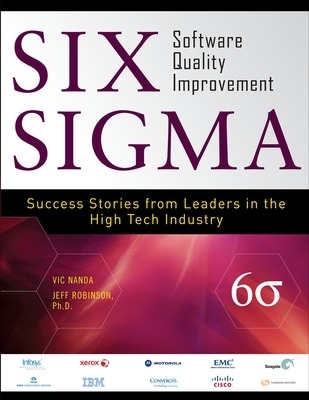
Six Sigma Software Quality Improvement
McGraw-Hill Professional (Verlag)
978-0-07-170062-7 (ISBN)
Publisher's Note: Products purchased from Third Party sellers are not guaranteed by the publisher for quality, authenticity, or access to any online entitlements included with the product.
Proven techniques for improving software and process quality with Six Sigma
This practical, in-depth guide explains how to apply Six Sigma to solve common product and process improvement challenges in the software and IT industry. Six Sigma Software Quality Improvement covers Define, Measure, Analyze, Improve, and Control (DMAIC), Lean Six Sigma, Design for Six Sigma (DFSS), and Define, Measure, Analyze, Design, and Verify (DMADV). Featuring more than 20 success stories from Motorola, IBM, Cisco, Seagate, Xerox, Thomson Reuters, TCS, EMC, Infosys, and Convergys, the book offers first-hand accounts of corporate Six Sigma programs and explains how these companies are successfully leveraging Six Sigma for software process and quality improvement.
The success stories reveal how:
Motorola minimized business risk before changing business-critical applications
TCS improved fraud detection for a global bank
Infosys improved software development productivity for a large multinational bank
IBM reduced help desk escalations and overhead activities
EMC improved development productivity
Motorola realized significant cost avoidance by streamlining processes and project documentation
Xerox achieved high-speed product development
Seagate reduced application downtime and improved availability to 99.99%
Cisco successfully reinvented its Six Sigma program
Convergys injected Six Sigma into the company's DNA
Thomson Reuters' Six Sigma program gathered significant momentum in a short time
Six Sigma was successfully applied in many other projects for defect reduction, cycle time reduction, productivity improvement, and more
Vic Nanda is a Process Improvement Manager, Broadband Mobility Solutions IT, with Motorola. He is a Certified ISO 9000 Lead Auditor, Certified Manager of Quality/Organization Excellence (CMQ/OE), Certified Quality Auditor (CQA), Certified Software Quality Engineer (CSQE), ITIL Foundations Certified, and Six Sigma Black Belt. Jeffrey Robinson, Ph.D., is a Master Black Belt and ITIL Program Manager with American Express. He has worked in software development and computer integrated manufacturing for more than 20 years. Dr. Robinson is a CMM/CMMI assessor and Malcolm Baldrige Quality Assessor. He has been teaching graduate and undergraduate courses for more than 20 years, and he holds four software patents in manufacturing control theory.
Chapter 1. Executive Overview of Six Sigma
PART ONE: DMAIC PROJECTS
Chapter 2. DMAIC Primer
Chapter 3. How Motorola Minimized Business Risk before Changing Business-Critical Applications
Chapter 4. TCS Reduces Turn-Around Time for Software Change Requests
Chapter 5. Defect Reduction
Chapter 5A. How TCS Helped a Major Global Bank Reduce Customer Complaints
Chapter 5B. Improving Test Effectiveness the Six Sigma Way
Chapter 6. Help Desk Improvement
Chapter 6A. EMC: Improving Development Productivity
Chapter 6B. Infosys Helps a Global Bank Reduce Business Risk from Errors in Online Banking Applications
Chapter 6C. Infosys Significantly Reduces Telecom Client's Operational Expenses
Chapter 7. Productivity Improvement
Chapter 7A. TCS Improves Fraud Detection for a Global Bank
Chapter 7B. Infosys Improves Software Development Productivity for a Large Multinational Bank
Chapter 8. DMAIC Conclusions and Lessons Learned
PART TWO: LEAN SIX SIGMA PROJECTS
Chapter 9. Lean Primer
Chapter 10. Leaning Six Sigma Projects: How to Run a DMAIC Project in Five Days
Chapter 11. How IBM Reduced Help Desk Escalations and Overhead Activities
Chapter 12. Motorola Realizes Significant Cost Avoidance by Streamlining Project Documentation
Chapter 13. Boiling the Ocean with Value Streams, Kaizens, and Kanbans
Chapter 14. How a Global Retailer Improved the Reliability Software Development and Test Environments
Chapter 15. Lean Conclusions and Lessons Learned
PART THREE: DESIGN FOR SIX SIGMA PROJECTS
Chapter 16. DFSS Primer
Chapter 17. How to Radically Streamline Your Business Processes
Chapter 18. How Motorola Reduced the Effort Required for Software Code Reviews
Chapter 19. Predictive Engineering to Improve Software Testing
Chapter 20. Improving Product Performance Using Software DFSS
Chapter 21. High-Speed Product Development at Xerox
Chapter 22. How Seagate Technology Reduced Downtime and Improved Availability to 99.99 Percent
Chapter 23. DFSS Conclusions and Lessons Learned
PART FOUR: SIX SIGMA PROGRAMS
Chapter 24. Cisco Successfully Reinvents Its Six Sigma Program
Chapter 25. Six Sigma Practice at Thomson Reuters
Chapter 26. How Convergys Injected Six Sigma into the Company DNA
Chapter 27. Bumps in the Road
Appendix A: Chapter Tools Matrix
Appendix B: Computing Return on Investment
Glossary
Contributor Biographies
Company Profiles
Index
| Erscheint lt. Verlag | 16.5.2011 |
|---|---|
| Zusatzinfo | 95 Illustrations |
| Sprache | englisch |
| Maße | 196 x 241 mm |
| Gewicht | 1219 g |
| Themenwelt | Mathematik / Informatik ► Informatik ► Software Entwicklung |
| Technik ► Maschinenbau | |
| Wirtschaft ► Betriebswirtschaft / Management ► Logistik / Produktion | |
| Wirtschaft ► Betriebswirtschaft / Management ► Wirtschaftsinformatik | |
| ISBN-10 | 0-07-170062-5 / 0071700625 |
| ISBN-13 | 978-0-07-170062-7 / 9780071700627 |
| Zustand | Neuware |
| Haben Sie eine Frage zum Produkt? |
aus dem Bereich


